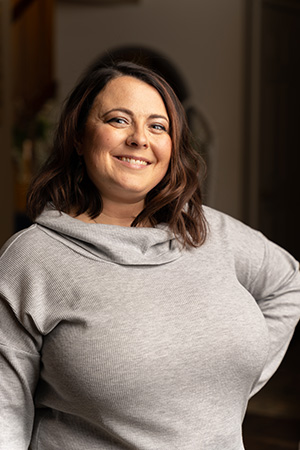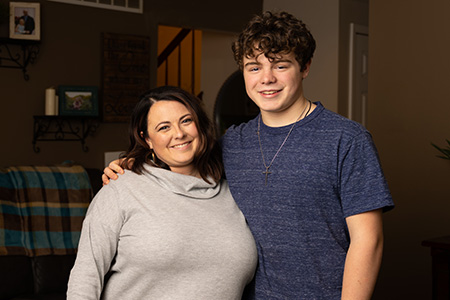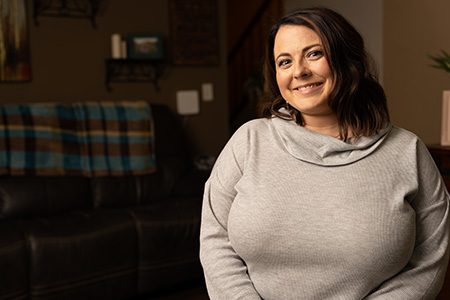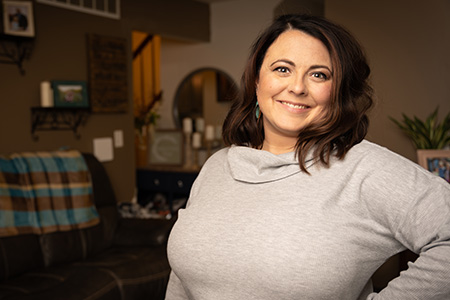From Provider to Patient
 What do you do when you’re expecting your first child and you’re told you have heart failure and only a 33 percent chance of survival?
What do you do when you’re expecting your first child and you’re told you have heart failure and only a 33 percent chance of survival?
This was the terrifying dilemma faced by Ashley Lobocki in 2008. Just 24 years old at the time, Ashley had lived an active life, including participating in cheerleading at the national level when she was younger, and gymnastics.
“I was active into my 20s, coaching and working out with the Eastern Michigan University cheer team,” she says.
After she graduated, Ashley started working at Henry Ford Health as an ER nurse. She became certified in several cardiac areas and worked with heart failure and heart transplant patients. Throughout her career, she has also helped out as an educator at Henry Ford West Bloomfield Hospital, participated in quality and process improvement committees, and assisted in helping develop education programs for home care agencies.
A dire situation
Given her active lifestyle and extensive work with heart patients, it came as a complete shock when Ashley began experiencing her own cardiovascular symptoms in the first three months of her pregnancy.
“From early on, I lost a bunch of weight and I wasn’t gaining it back,” she says. “My heart rate sped up. I started to get really tired and winded, and eventually, I couldn’t walk from one place to another without being completely exhausted.”
Ashley planned to work until just before she gave birth, given that she was the primary breadwinner at the time. But her symptoms progressed.
“I had a hard time breathing, and I couldn’t finish sentences,” she says. “My heart rate at rest was in the 140s.”
Ashley had an echocardiogram, a diagnostic test that uses electrodes and ultrasound to evaluate how the heart’s chambers and valves are functioning. Based on the test results, she was referred to the Henry Ford cardiology team.
“The chief of heart failure and transplant at the time called me directly,” Ashley says. “She told me that my situation was extremely serious, and that I needed to come see them right away.”
Ashley was diagnosed with peripartum cardiomyopathy, a pregnancy-related heart failure condition that affects 1 in 10,000 women. Her prognosis was not good. She learned that 1/3 of the patients in her situation die or need a transplant, 1/3 live with severe heart failure that can get worse at some point, and 1/3 remain stable, with no change in their condition.
“The doctor told me I was a severe case, and that her current focus was on keeping me alive,” Ashley says. “They did lots of testing.”
Ashley’s ejection fraction (EF), which is a measure of the heart’s pumping efficiency, was at 35%. When they tested again a month later, it had dropped to the low 20s. According to the American Heart Association, a normal EF ranges between 50 to 75%.
The team mobilizes
 Her heart failure team was concerned not only about her heart condition, but also her pregnancy, given that delivering her child would strain Ashley’s heart even more. They referred her to a fetal medicine specialist. But the night after her first appointment, Ashley’s condition suddenly got worse.
Her heart failure team was concerned not only about her heart condition, but also her pregnancy, given that delivering her child would strain Ashley’s heart even more. They referred her to a fetal medicine specialist. But the night after her first appointment, Ashley’s condition suddenly got worse.
“I couldn’t breathe,” she says. “My legs were swollen and my heart rate was spiking into the 150s. My husband at the time rushed me to the hospital, and they admitted me right away.”
She underwent even more testing.
“They wanted to make sure I didn’t have a pulmonary embolism on top of everything else,” she says. “While they would normally do a CT with contrast, I’m allergic to iodine.”
Besides testing workarounds, Ashley’s team also discussed the safest delivery plan for both Ashley and her baby. On the one hand, they wanted the baby to develop in vitro as much as possible before delivery, which would be better for the baby and also less stress on her body. But Ashley’s failing heart was forcing the issue, so they decided to induce.
“I thought a C-section would be better, she says. “But they explained that this would actually be a much greater stress on my body than a natural delivery. They wanted to induce labor, because they were concerned the longer the stress on my heart continued, the weaker it would become and the greater the risk I could die.”
Ultimately, Ashley was induced and delivered her son Brady in February 2008, eight weeks before he was due.
“I was terrified for him, being so premature,” she says. “But everyone was great. Once we got to the delivery room, there were about 10 docs and nursing staff in there at all times, so I felt like I was in good hands.”
After Brady was born, they put him on Ashley’s chest so she could see him, then whisked him away to the neonatal intensive care unit. While Brady did well, Ashley couldn’t see him for several days.
“That was hard,” she says. “My father-in-law at the time brought a printer to the hospital, took photos of Brady and printed them out so I could see him.”
Downs, then ups
 Once Ashley and Brady were home, she went in for regular follow-ups for her ongoing symptoms, and more testing.
Once Ashley and Brady were home, she went in for regular follow-ups for her ongoing symptoms, and more testing.
“I could barely hold Brady sitting down,” she says. “I needed help bathing and showering. I couldn’t breathe well, especially in the heat. I did so much testing. So many echocardiograms, so many titrated meds, metabolic testing. It was constant.”
And at first, it didn’t work. Ashley’s EF plummeted to 17%, and she began to do the testing necessary to get on the heart transplant eligibility list.
“I had a newborn at home, and all I wanted was to be a mom,” she says. “I was motivated to fix this. I was diligent with my medications, and made significant changes to my diet. I come from a Southern family, so I had a lot of bad habits, especially too much salt intake, which was causing my legs and feet to get swollen. So I started making things homemade, and swapped out the salt for other seasonings.”
Ashley’s condition improved, and she no longer needed a heart transplant. For about 11 years, she had some ups and downs, but for the most part was doing well.
The impact of COVID-19
Then the pandemic hit.
“I had COVID in the fall of 2020,” she says. “My heart failure symptoms got worse, and I developed pneumonia in both lungs. Being a nurse, I did a lot of deep breathing techniques and other lung workouts such as chest physical therapy.”
Over the next few months, her heart failure worsened, she started retaining more fluid, experienced more swelling and also developed high blood pressure. Her care team added several medications to her regimen and adjusted the doses to help manage her symptoms.
Shortly after this, in the spring of 2021, her heart failure specialist, Celeste Williams, M.D., referred Ashley to a virtual heart study with one of her colleagues, David Lanfear, M.D. The study included a new heart failure medication, which was delivered to patients’ homes. Participants then used a mobile app and a Fitbit to monitor their physical activity, and completed online symptom surveys.
“I have an educator background and have done other studies before, and I was motivated to take part in this one,” Ashley says. “The virtual format was great. I’m remarried and, besides Brady, I have two stepkids. They’re involved in so many things and I have to work, so not having to travel anywhere for the study made it very easy.”
A new normal, and a new venture
 Now 38, Ashley’s life is very different. While she worked as a nurse for a while after her initial treatment, she began to scale back. After getting COVID-19, she left the nursing life altogether.
Now 38, Ashley’s life is very different. While she worked as a nurse for a while after her initial treatment, she began to scale back. After getting COVID-19, she left the nursing life altogether.
These days, she works from home, where she manages a marketing and publicity company for authors, and currently serves as the publishing director. She also co-owns a book promotions company that engages with both authors and readers.
In addition, Ashley has adjusted to her ongoing health issues, including the need to continually monitor her medications with her care team, and to make adjustments as time goes on to help control her symptoms.
“I still get tired,” Ashley says. “It’s tough, because I used to be so active, and now it’s difficult to even hike with my family, which I love to do. I want to enjoy things, but I have to manage my expectations. Things take longer, but I need to force myself to keep moving.
“Doctors and nurses can give you the tools to make you better, but you have to educate and empower yourself every day. Women, especially moms, are so busy taking care of others that they often neglect their own needs. So, we need to remember to take care of ourselves, too.”
Ashley’s also still diligent about keeping in touch with her Henry Ford Health heart failure team.
“I could never leave as a patient and go anywhere else,” she says. “They care about their patients, and I would absolutely bet my life—and have by the way—that they are the best out there."
.svg?iar=0&hash=F6049510E33E4E6D8196C26CCC0A64A4)

/hfh-logo-main--white.svg?iar=0&hash=ED491CBFADFB7670FAE94559C98D7798)